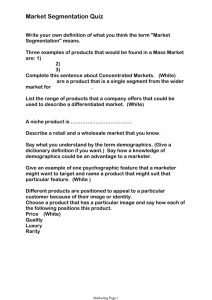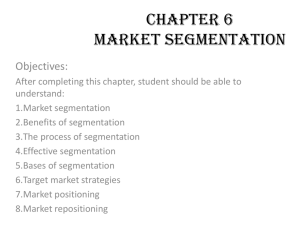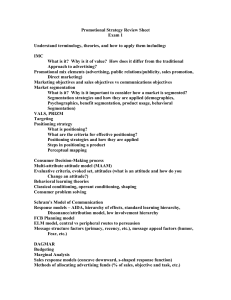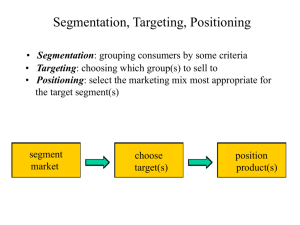Market Segmentation and Selection
advertisement
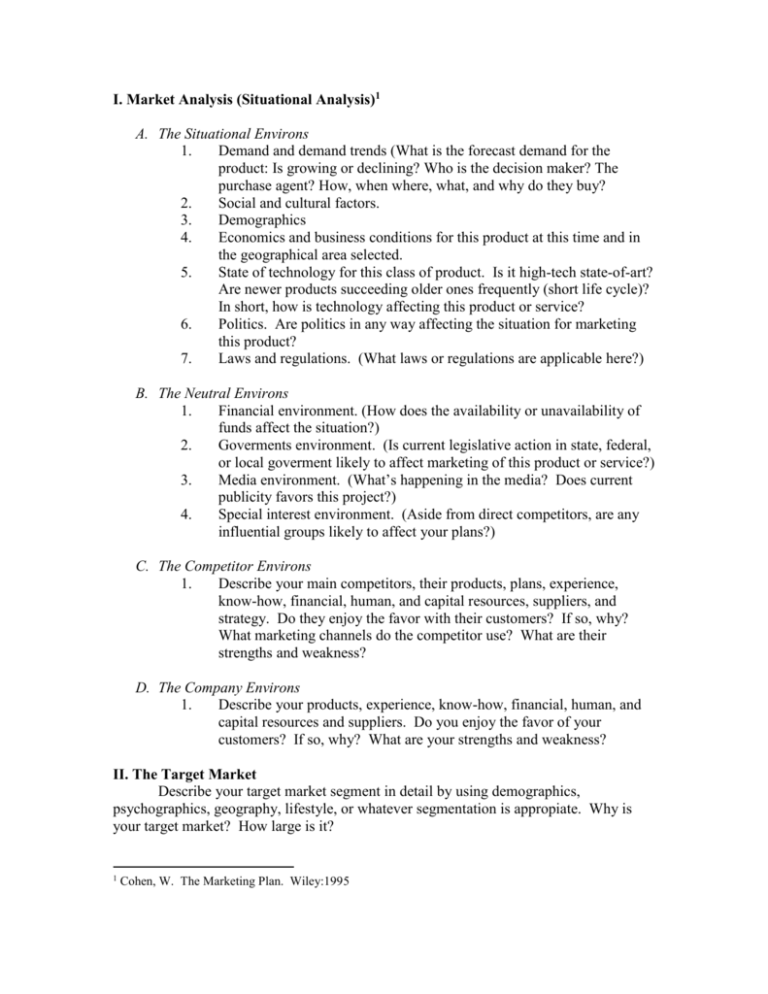
I. Market Analysis (Situational Analysis)1 A. The Situational Environs 1. Demand and demand trends (What is the forecast demand for the product: Is growing or declining? Who is the decision maker? The purchase agent? How, when where, what, and why do they buy? 2. Social and cultural factors. 3. Demographics 4. Economics and business conditions for this product at this time and in the geographical area selected. 5. State of technology for this class of product. Is it high-tech state-of-art? Are newer products succeeding older ones frequently (short life cycle)? In short, how is technology affecting this product or service? 6. Politics. Are politics in any way affecting the situation for marketing this product? 7. Laws and regulations. (What laws or regulations are applicable here?) B. The Neutral Environs 1. Financial environment. (How does the availability or unavailability of funds affect the situation?) 2. Goverments environment. (Is current legislative action in state, federal, or local goverment likely to affect marketing of this product or service?) 3. Media environment. (What’s happening in the media? Does current publicity favors this project?) 4. Special interest environment. (Aside from direct competitors, are any influential groups likely to affect your plans?) C. The Competitor Environs 1. Describe your main competitors, their products, plans, experience, know-how, financial, human, and capital resources, suppliers, and strategy. Do they enjoy the favor with their customers? If so, why? What marketing channels do the competitor use? What are their strengths and weakness? D. The Company Environs 1. Describe your products, experience, know-how, financial, human, and capital resources and suppliers. Do you enjoy the favor of your customers? If so, why? What are your strengths and weakness? II. The Target Market Describe your target market segment in detail by using demographics, psychographics, geography, lifestyle, or whatever segmentation is appropiate. Why is your target market? How large is it? 1 Cohen, W. The Marketing Plan. Wiley:1995 Market Segmentation and Selection2 Market segmentation is the process of dividing all possible users of a product into groups that have similar needs the products might satisfy. Market segmentation should be done prior to the final development of a new product. Market Segmentation 1. Identify segmentation variables and segment the market 2. Develop profiles of resulting segments Market Targeting 3. Evaluate the attractiveness of each segment 4. Select the target segment(s) Market Positioning 5. Identify possible positioning concepts for each target segment 6. Select, develop and communicate the chosen positioning concept Segmentation Variables I. Geographic Region, urban, suburban, size of city, population density, climate. II. Demographic Age, gender, family size, family life cycle, income, occupation, education, religion, race, nationality. III. Psychosocial Social class, lifestyle, personality, references group( those you turn to for information). IV. Behaviors and Feelings Attitudes, benefits sought, readiness stage, perceived risk, innovativeness, involvement, loyalty status, usage rate, user status, usage situation, price sensitivity. 2 Hawkins, Best & Coney. Consumer Behavior: Implications for Marketing Strategy. Irwin:1995 TARGET MARKET Geographical location _______________________________________ Special Climate or topography ________________________________ CONSUMER BUYERS Cultural, ethnic, religious, or racial groups _______________________ Social class(es) _____________________________________________ References group (s) ________________________________________ Basic Demographics: Sex ______ Age Range __________________ Education ________ Income _____________________ Household size description ___________________________________ Stage of family life cycle _____________________________________ Family work status: Husband _______ Wife _________________ Occupation ( Husband and wife) _______________________________ Decision maker _______________ Purchase agent ________________ Risk perception: Functional ___________ Psychological ___________ Physical _____________ Social ______________ Financial _________ Income for each family member ________________________________ Disposable income ____________________________________________ Additional descriptions, classifications, and traits of target market________ _____________________________________________________________ Target market wants and needs 1. _________________________________ 2.________________________ 3. ________________________________ Product general description ______________________________________ Frequency of usage____________________ Traits ____________________ Size of target market ____________________________________________ Growth trends _________________________________________________ ORGANIZATIONAL BUYER Decision makers __________________________________________ ________________________________________________________ Primary motivation of each decision maker _____________________ ________________________________________________________ Amount of money budgeted for purchase ______________________ ________________________________________________________ Purchase history __________________________________________ ________________________________________________________ Additional descriptions, classifications, and traits of target market___ ________________________________________________________ ________________________________________________________ Target market wants and needs: 1. ___________________________ 2._____________________________ 3. ______________________ Product general description _________________________________ _______________________________________________________ Frequency of usage _________________ Traits ________________ Size of target market _____________________________________ Growth trends ___________________________________________
